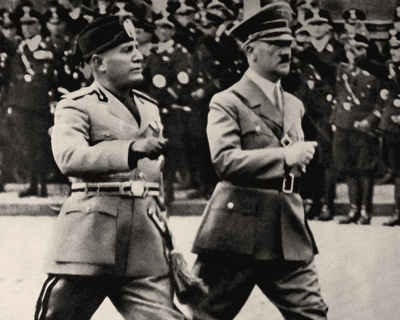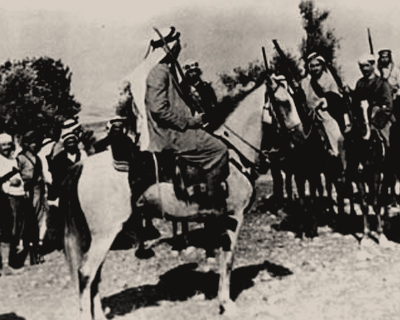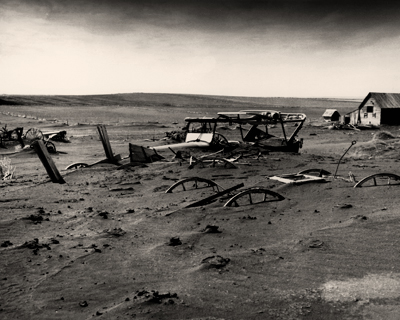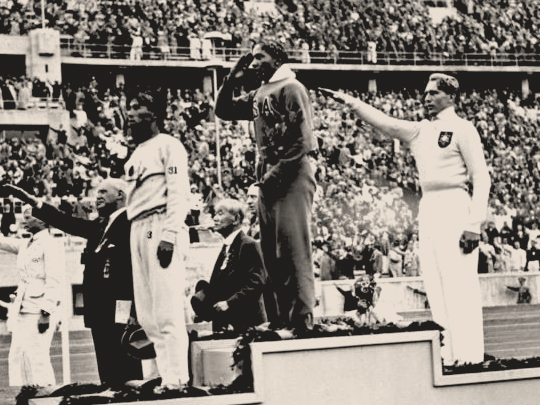Wikimedia Commons / CC-BY-SA-3.0 / GFDL
1 – Jesse Owens Wins 4 Gold Medals at Berlin Olympics
Jesse Owens was an American track and field athlete, four-time Olympic gold medalist in the 1936 Berlin games.
He was the most successful athlete at the games, winning gold in the 100 meters, 200 meters, long jump, and 4 × 100-meter relay.
Hitler’s architect, Albert Speer wrote that Hitler “was highly annoyed by the series of triumphs by the marvelous colored American runner, Jesse Owens.
People whose antecedents came from the jungle were primitive, Hitler said with a shrug; their physiques were stronger than those of civilized whites and hence should be excluded from future games.”
Contrary to belief at the time, Hitler did shake Owens’ hand before he left the stadium behind the honor stand.
In Germany, Owens had been allowed to travel with and stay in the same hotels as whites, at a time when African Americans in many parts of the United States had to stay in segregated hotels.
Upon their return, during a Manhattan ticker-tape parade in his honor, someone handed Owens a paper bag. Owens paid it little attention until the parade concluded. When he opened it up, he found it contained $10,000 in cash.
After the parade, Owens was not permitted to enter through the main doors of the Waldorf Astoria New York. He was instead forced to travel up to the event in a freight elevator to reach the reception honoring him.
President Franklin D. Roosevelt never invited Jesse Owens to the White House following his triumphs at the Olympics games. Owens later said he was treated better in Germany than in America.
2 – Rome-Berlin Axis is Proclaimed

The Axis powers were the nations that fought in World War II against the Allied forces, Germany, Italy & Japan. The Axis powers agreed on their opposition to the Allies but did not completely coordinate their activity.
The Axis grew out of the diplomatic efforts of the countries to secure their own specific expansionist interests in the mid-1930s.
The first step was the treaty signed by Germany and Italy on 25/26 October 1936. Mussolini declared on 1 November that all other European countries would from then on rotate on the Rome–Berlin axis, thus creating the term “Axis”.
The second step was the signing on 25 November 1936 of the Anti-Comintern Pact, an anti-communist treaty between Germany and Japan. Italy joined the Pact in 1937.
The “Rome–Berlin Axis” became a military alliance in 1939 under the so-called “Pact of Steel”, with the Tripartite Pact of 1940 leading to the integration of the military aims of Germany and its two treaty-bound allies.
At its zenith during World War II, the Axis presided over territories that occupied large parts of Europe, North Africa, and East Asia.
3 – The Great Purge Begins

The Great Purge was a campaign of political repression in the Soviet Union which occurred from 1936 to 1938.
It involved a large-scale purge of the Communist Party and government officials, repression of peasants and the Red Army leadership, widespread police surveillance, imprisonment, and arbitrary executions.
In Russia, the period of the most intense purge, 1937–1938, is called ‘Yezhovshchina‘ (commonly translated as “times of Yezhov”), after Nikolai Yezhov, the head of the Soviet secret police, NKVD.
It has been estimated between 600,000 and 1.2 million people were murdered by the Soviet government during this period.
4 – Arab Revolt in Palestine

The 1936–1939 Arab revolt was a nationalist uprising by Palestinian Arabs in Mandatory Palestine against British colonial rule, as a demand for independence.
The dissent was directly influenced by the Qassamite rebellion, following the killing of Sheikh Izz ad-Din al-Qassam in 1935, as well as the declaration by Hajj Mohammad Amin al-Husayni of 16 May 1930 as ‘Palestine Day’.
The revolt was branded by many in the Jewish Yishuv as “immoral and terroristic”, often comparing it to Fascism and Nazism.
David Ben Gurion, however, described Arab causes like fear of growing Jewish economic power, and opposition to mass Jewish immigration.
According to official British figures, the army and police killed more than 2,000 Arabs in combat, 108 were hanged, and 961 died because of “gang and terrorist activities”.
Estimates of the number of Palestinian Jews killed range from 91 to several hundred.
However, in an analysis of the British statistics, the Palestinian historian, Walid Khalidi estimates 19,792 casualties for the Arabs, with 5,032 dead: 3,832 killed by the British and 1,200 dead because of “terrorism”, and 14,760 wounded.
Over ten percent of the adult male Palestinian Arab population between 20 and 60 was killed, wounded, imprisoned or exiled.
5 – The Dust Bowl

The Dust Bowl was a period of severe dust storms that greatly damaged the ecology and agriculture of the US and Canadian prairies during the 1930s.
Severe drought and a failure to apply dryland farming methods to prevent wind erosion caused the phenomenon.
The drought came in three waves, 1934, 1936, and 1939–40, but some regions experienced drought conditions for up to eight years.
With an insufficient understanding of the ecology of the plains, farmers had conducted extensive deep plowing of the virgin topsoil during the previous decade, which had displaced the native, deep-rooted grasses that normally trapped soil and moisture.
The rapid mechanization of farm equipment, especially small gasoline tractors and the widespread use of the combine harvester contributed to farmers’ decisions to convert arid grassland to cultivated cropland.
During the drought of the 1930s, the unanchored soil turned to dust, which the prevailing winds blew away in huge clouds that sometimes blackened the sky. On the Plains, they often reduced visibility to 1 meter or less.
These choking billows of dust traveled cross country, reaching the East Coast and striking such cities as New York City and Washington, D.C.
The drought and erosion of the Dust Bowl affected 100,000,000 acres that centered around Texas and Oklahoma and touched sections of New Mexico, Colorado, and Kansas.
It forced tens of thousands of families to abandon their farms. Many of these families migrated to California and other states to find that the Great Depression had made economic conditions there little better than those they had left.









